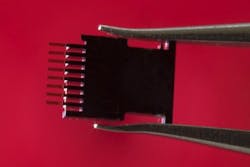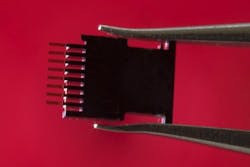Optical biosensor can detect HIV only one week after infection
A team of researchers from the Spanish National Research Council (CSIC; Madrid, Spain) has developed and patented an optical biosensor that is able to detect human immunodeficiency virus (HIV) a week after being infected, with total test time of 4 hours and 45 minutes—so clinical results could be obtained on the same day.
Related: Fluorescence approach can track HIV proteins' motion in real time
The biosensor combines micromechanical silicon structures with gold nanoparticles, both functionalized with p24-specific antibodies. At the end of the immunoassay procedure, p24 is sandwiched between the gold nanoparticles and the micromechanical silicon structures. The gold nanoparticles have optical resonances known as plasmons, which are capable of scattering light very efficiently. Micromechanical structures are excellent mechanical sensors capable of detecting interactions as small as intermolecular forces. The combination of these two structures produces both mechanical and optical signals that amplify one another, producing remarkable sensitivity, to detect the p24.
"The biosensor uses structures which are manufactured using well-established microelectronics technology, thus making large-scale, low-cost production possible," says CSIC researcher Javier Tamayo, who works at the Institute of Microelectronics in Madrid. "This, combined with its simplicity, could make it a great choice for use in developing countries," he notes.
The experiment begins by incubating one milliliter of human serum on the sensor for one hour at 37°C to allow binding of any existing HIV-1 p24 antigens to the capture antibodies located on the sensor's surface. Next, it is re-incubated at 37°C, though in this case with gold nanoparticles, for 15 minutes so the captured p24 proteins can be marked. Finally, the resulting material is rinsed to remove any unbound particles. "The test takes a total of 4 hours, 45 minutes, which is really rapid. In fact, to confirm the diagnosis, you could even repeat the test and the clinical results could be back on the same day as the medical examination. The results are statistically significant and could be adapted to medical requirements," Tamayo explains.
"This new technology is capable of detecting p24 at concentrations up to 100,000 times lower than the previous generation of approved immunoassay methods, and 100 times lower than methods for detecting viral RNA in blood," says CSIC researcher Priscila Kosaka, also from the Institute of Microelectronics. "This reduces the undetectable phase after infection to just one week."
The period between infection and seroconversion is approximately four weeks, so the early detection of HIV is crucial to improving a person's health. Progressive changes occur after HIV acquisition, such as irreversible depletion of gut CD4 lymphocytes, replication in the central nervous system, and the establishment of latent HIV reservoirs. "The potential for HIV infectivity in the first stage of infection is much higher than in the later stages. Therefore, initiating antiretroviral therapy prior to seroconversion improves immune control and has been associated with benefits in CD4 cell count, a reduction in systemic inflammation, the preservation of cognitive function, and a reduction of the latent reservoir. Logically, its detection is critical to the prevention of HIV transmission," Kosaka explains.
The CSIC research team's technology, which is also being applied in the early detection of certain types of cancer, has been licensed to the Mecwins company, a CSIC spinoff created in 2008 by Tamayo and Montserrat Calleja. This recent research has received funding from the Spanish Cancer Association.
Full details of the work appear in the journal PLoS ONE; for more information, please visit http://dx.doi.org/10.1371/journal.pone.0171899.

